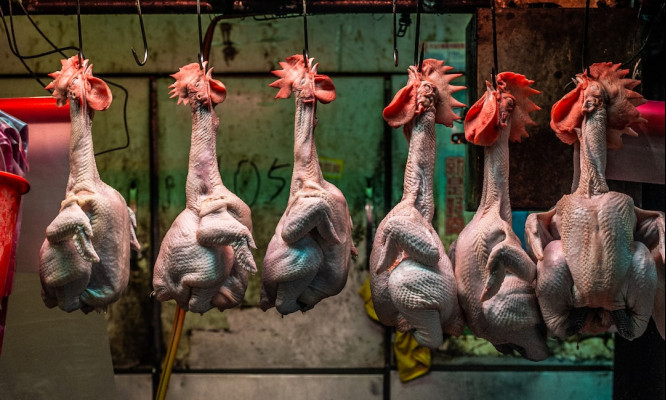When I was around 12 years of age, my father brought home ten chickens that had stopped laying. Being a thrifty fellow, he thought it would be a good idea to put these birds in the freezer to feed the family as the occasion arose. He put the birds on a chopping block and, one by one, he began lopping off their heads. The headless chickens hopped around the yard for 30 seconds, or so, before they finally stopped moving. It was a crazy thing to see, and an experience that I’ll never forget.
That was some old-school butchery for sure. Home chicken butchering need not be so brutal. There are tools and methods for processing meat birds that are much more humane, not to mention far less messy.
Tools You Will Need.
As I mentioned in a previous post, these are the tools you will need to butcher your broilers, or any chicken for that matter, in a safe and relatively humane way:
- A sharp boning knife
- A butchering cone to keep the chicken stable during the bleeding process
- A hose with running water, or something similar (lots of blood)
- A table to butcher on
- Garbage bags. You’ll want to remove entrails and such immediately
- An ice chest for the butchered and rinsed chickens
- A scalding tank to loosen feathers for plucking
…just quickly…the knife is for making the cut for bleeding the chicken and for other cuts. The cone is to stabilize the bird to keep it from spraying blood and to prevent nightmarish hopping around. The scalding tank is for loosening the feathers for plucking. All the rest should be self-explanatory.
The Fasting, Killing/Bleeding, Scalding, and The Plucking
Killing is not the first step in butchering, fasting is. At least 24 hours of fasting is needed to rid the birds gullet and intestines of contamination-causing byproducts. To do this, you’ll want to isolate them in a wire cage off the ground so that they can’t pick at anything and try to eat it. Provide plenty of fresh water during this phase to help with the cleansing.
To kill, simply put the birds in your cone, hold the head still, and cut the jugular just behind the earlobe. Make about a two-inch cut, and use some pressure so you won’t have to do it twice. Allow the bird up to a minute to bleed out and die.
Scalding water must be about 140 degrees Fahrenheit (60 Celsius). You do not want to cook your chickens, you just want to loosen the feathers. You’ll want a pot large enough to submerse your chickens completely. Dip the chicken in the scalding water for two or three seconds, depending on the temperature of the water. Pull it out for a few seconds. Dip it in again for two to three seconds, moving the carcass around to make sure the water is hitting the skin. Pull it out and try pulling some feathers. If they come out easily, keep on plucking. If not, repeat process until they do.
Rubbing and pulling the feathers with a little force will finish the bird in 5-10 minutes. You’ll get faster and establish your own routine with practice. If there are pin feathers, pull them out. If there are hairs, carefully burn them off. Voila! Your chicken is plucked.
Cleaning Out
Now you have a plucked meat bird with head and feet still attached. They have to come off.
Cut off the feet at the joint that looks like a backward knee. Just get your knife tip in there and this should be pretty easy.
Cut off the head as close to the body as possible. Pruning shears are good to cut through the neck bone. Cut through any remaining skin.
Now you have to eviscerate the bird. Lay the chicken on a table, grab a hold of the skin above the vent and make a horizontal slit in the skin. Reach in and open up the body cavity. Now reach in and scoop out the entrails with a cupped hand. Be careful not to rupture anything. Any poop on the chicken will contaminate the meat. Now find the tube-like structure that is the bird’s windpipe, and pull that out. The innards will still be attached.
You will use your sharp knife and gently cut a ‘v’ shape around the vent. Take special care to not puncture the intestines or the vent. Cut around it and remove it completely. You can save the heart, liver, and gizzard if you want to.
Rinse everything with potable water.
Preparing For The Fridge And Freezer
It is important to chill the chicken as quickly as possible. You need to get the body down to 40 degrees Fahrenheit as soon as possible. A large chest of ice works well to accomplish this. Another way to do it is by constantly running cold water over the processed chicken until it comes down to the water’s temperature, then putting it on ice.
Once the chicken has become cold enough, it needs to be hung to dry, or placed on a sanitary rack to dry. This should only take 20 minutes or so.
After the chickens are cool and dry, they can be bagged and refrigerated, or frozen for later use. Refrigerated chicken only lasts a few days under refrigeration, so if you’re not going to eat it right away, freeze it.
Nothing like Homemade
Just like pies, cookies, bread, ice cream, and maple syrup, there’s nothing quite like homemade. Butchering your own meat birds brings satisfaction not only to you, the butcher, but to your family and your family’s taste buds as well.
Home chicken butchering is a practice that has fallen by the wayside dramatically since the mid twentieth century, when small farms were the norm. Most people these days probably have no idea of what it takes to bring a live animal from the pasture to the table. Hopefully, with the information you have here, you can raise your own meat chickens in a way that is truly farm to table.
Thanks for reading. Please let me know if you have any questions.


